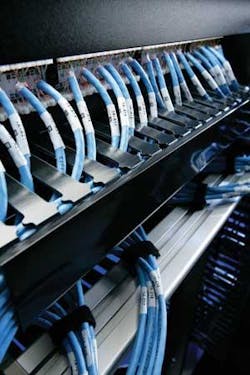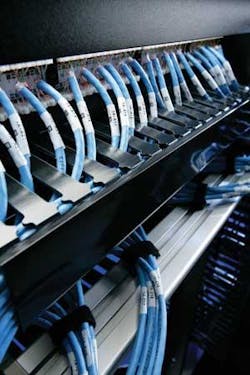Efforts underway within the TIA, ISO/IEC, and CENELEC yield some similarities and some differences.
by Patrick McLaughlin
Development continues on the third generation of the Telecommunications Industry Association's (TIA; www.tiaonline.org) 606 Administration Standard for Commercial Telecommunications Infrastructure, at the same time international standards bodies—including the International Organization for Standardization/International Electrotechnical Commission (ISO/IEC; www.standardsinfo.net) and the European Committee for Electrotechnical Standardization (CENELEC; www.cenelec.eu)—proceed with their own standards efforts.
Over the past year–plus, the primary driver of change within the administration/labeling environment, and therefore a significant impetus for change in the TIA's 606 standard series, has been the data center (see "TIA labeling standard marked for changes," March 2008). After affirming the 606–A standard in June 2007, the TR–42.6 Telecommunications Infrastructure and Equipment Administration Committee initiated work on the firstaddendum to the specifications, specifically intendedto synch up the standard's specifications with thoseof the TIA–942 Telecommunications InfrastructureStandard for Data Centers.
Addendum 1 to 606–A
The intention of Addendum 1 to 606–A is to reconcile the fact that the 942 standard handles data center administration—as in planning and operating a facility—and the 606–A standard deals with telecommunications system administration in the form of identification.
"It made sense to bring the two together," explains Todd Fries, market manager for identification products with HellermannTyton (www.hellermanntyton.com).Addendum 1 to 606–A allows data center managers to "administer everything from the basic to the specific,and eventually out to the work area," Fries continues. (Fries' comments are from an interview that can be viewed at www.cablinginstall.com.)
As of the TR–42.6's June 2008 meeting, the group had resolved all industry–ballot comments and submittedthe document for a default ballot.
While the final details of 606–A Addendum 1 are put into place, the 42.6 Committee is simultaneously workingon a full–fledged next–generation set of specifications,TIA–606–B. "We're taking all the data–center information inAddendum 1 and integrating it into 606–B to make that a more–complete document," says Fries. "We're also looking at otheraspects that might be considered enhancements—not so much corrections as answers to the questions: ‘How can we do this better? What's being done in the real world? What services the engineering side and installer side?' We'll marry the two together to create and sustain a morecomprehensive document."
Attempting global harmony
As for the legwork within TR–42.6 to get 606–B published, committee vice–chair Jonathan Jew of J&M Consultants (www.j–and–m.com) explains the efforts that have already been made to harmonize the specifications with those of other standards–making groups: "Before we started work on a 606–B draft, we were able to get the ISO/IEC task group working on their 14763–2 standard to agree they would establish an identifier standard based on 606–A, including Addendum 1."
ISO's 14763 standard is entitled Information Technology—Implementation and Operation of Customer Premises Cabling. Revision 1 (14763–1) has been in publication for several years and Revision 2 is currently in progress.
"The standard has chapters on specification, quality planning (including planning of pathways and spaces), installation practices, testing, inspection, operation, maintenance and repair, as well as documentation and identification," says Jew. "The standard also has annexes on data centers, residential, and industrial. It will take some time for this document to be completed."
At the time of this writing, research was being done within the ISO standards group responsible for 14763–2 to ensure that the adoption of 606–A–based specifications does not conflict with any existing ISO standards. Jew optimistically anticipates there will be no such conflict, particularly because the proposal within ISO calls for 606–A–based identifiers to beapplied when no other identifiers are specified, or where those identifiers fail to meet the applications' requirements. Inother words, the 606–A–based identifier specifications would not supplant any existing specifications.
Those specifications within 606–A will be grandfathered into 606–B, and when published, the new standard will essentially include all the details of 606–A—and then some.
"The 606–B standard will identify space," says Fries. "The standard will drill down from the data center or telecommunications room to what is in that room—racks and cabinets, which are not identified in 606–A." The identifiers for racks and cabinets will bedetermined based on grid locations or simply by the row in which the rack or cabinet resides.
"The B standard will drill down further to the patch panel and the location of that patch panel, such as rack unit 45, or 37, or 28 for example," Fries continues. "It will identify a port or a range of ports. But it will not only identify the ports—the A standard does that—it will also indicate where those ports are going."
That is important in the data center, Fries points out,because the rack or cabinet is at a specific location, and it is beneficial to know the specific set of ports that are going to that rack or cabinet.
Furthermore, while 606–B will continue to use the designations included in 606–A, the new standard will also look at the broader picture. "As we move from the data center to the network operations center, we are administering different spaces, and eventually horizontal links to the work area," Fries says. The ‘B' standard, he explains, covers the full range of what must be identified.
Broader perspective
Jew also points out that within CENELEC, a proposal from the Swedish representative that is based on electrical rather than communications systems nonetheless exemplifies theexpansion of the spaces that should be identified. "The Swedish proposal manages outside pathways and includes unique identifiers for manholes" and other outside–plant elements,Jew notes. That proposal, he adds, reinforces the TR–42.6 group's expansion of scope to more than just buildings.
Moving ahead, the TR–42.6 committee meets (or met) this month (October 7) as part of the overall TR–42 Engineering Committee meeting taking place in Vancouver, BritishColumbia. Addendum 1 to 606–A will undoubtedly easecloser to finalization, and the liaison relationship between TR–42 and the ISO/IEC Joint Technical Committee 1 Subcommittee 25 Work Group 3 Cabling Installation Task Group (JTC–1 SC–25 WG–3 CITG) will continue in an attempt to harmonize the North American and international versions ofcabling system administration standards.
HellermannTyton's Fries summarizes the situation, "It's an exciting time to be involved with this. Many installers andengineers are excited about it; it has come of age that we have this information available."
Through the efforts of Fries, Jew, and many others, more information will become available in the near future.
Patrick McLaughlin is chief editor of Caling Installation & Maintenance.

